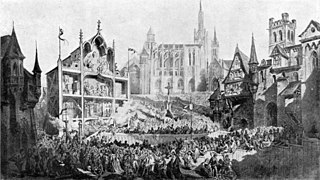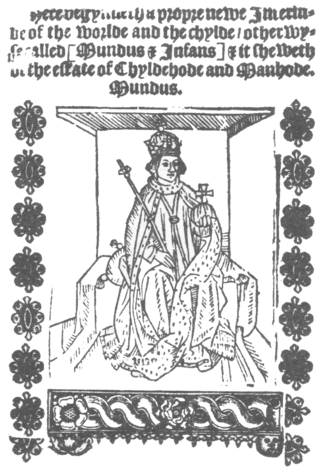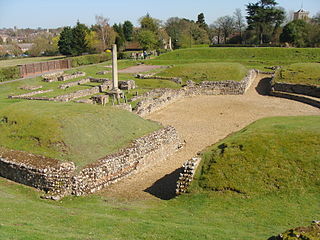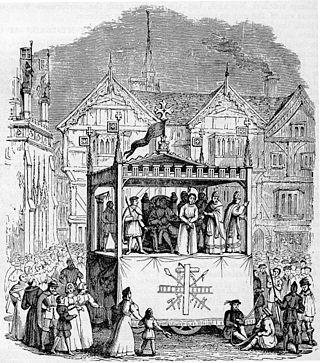
Mystery plays and miracle plays are among the earliest formally developed plays in medieval Europe. Medieval mystery plays focused on the representation of Bible stories in churches as tableaux with accompanying antiphonal song. They told of subjects such as the Creation, Adam and Eve, the murder of Abel, and the Last Judgment. Often they were performed together in cycles which could last for days. The name derives from mystery used in its sense of miracle, but an occasionally quoted derivation is from ministerium, meaning craft, and so the 'mysteries' or plays performed by the craft guilds.

The morality play is a genre of medieval and early Tudor drama. The term is used by scholars of literary and dramatic history to refer to a genre of play texts from the fourteenth through sixteenth centuries that feature personified concepts alongside angels and demons, who are engaged in a struggle to persuade a protagonist who represents a generic human character toward either good or evil. The common story arc of these plays follows "the temptation, fall and redemption of the protagonist".

The Massacreof the Innocents is an incident in the Nativity narrative of the Gospel of Matthew (2:16–18) in which Herod the Great, king of Judea, orders the execution of all male children who are two years old and under in the vicinity of Bethlehem. Christians venerate the Holy Innocents as the first Christian martyrs, but a majority of Herod biographers, and "probably a majority of current biblical scholars" consider the story fabricated or unhistorical.

Drama was introduced to Britain from Europe by the Romans, and auditoriums were constructed across the country for this purpose.

A medieval pageant is a form of procession traditionally associated with both secular and religious rituals, often with a narrative structure. Pageantry was an important aspect of medieval European seasonal festivals, in particular around the celebration of Corpus Christi, which began after the thirteenth century. This festival reenacted the entire history of the world, in processional performance, from Bible's Genesis to the Apocalypse, employing hundreds of performers and mobile scenic elements. Plays were performed on mobile stages, called waggons, that traveled through towns so plays could be watched consecutively. Each waggon was sponsored by a guild who wrote, designed, and acted in the plays.

The "Coventry Carol" is an English Christmas carol dating from the 16th century. The carol was traditionally performed in Coventry in England as part of a mystery play called The Pageant of the Shearmen and Tailors. The play depicts the Christmas story from chapter two in the Gospel of Matthew: the carol itself refers to the Massacre of the Innocents, in which Herod ordered all male infants under the age of two in Bethlehem to be killed, and takes the form of a lullaby sung by mothers of the doomed children.

The Chester Mystery Plays is a cycle of mystery plays originating in the city of Chester, England and dating back to at least the early part of the 15th century.
The N-Town Plays are a cycle of 42 medieval Mystery plays from between 1450 and 1500.

Medieval theatre encompasses theatrical performance in the period between the fall of the Western Roman Empire in the 5th century and the beginning of the Renaissance in approximately the 15th century. The category of "medieval theatre" is vast, covering dramatic performance in Europe over a thousand-year period. A broad spectrum of genres needs to be considered, including mystery plays, morality plays, farces and masques. The themes were almost always religious. The most famous examples are the English cycle dramas, the York Mystery Plays, the Chester Mystery Plays, the Wakefield Mystery Plays, and the N-Town Plays, as well as the morality play known as Everyman. One of the first surviving secular plays in English is The Interlude of the Student and the Girl.

The Parker Library is a library within Corpus Christi College, Cambridge which contains rare books and manuscripts. It is known throughout the world due to its invaluable collection of over 600 manuscripts, particularly medieval texts, the majority of which were bequeathed to the college by Archbishop of Canterbury Matthew Parker, a former Master of Corpus Christi College.
The Wakefield or Towneley Mystery Plays are a series of thirty-two mystery plays based on the Bible most likely performed around the Feast of Corpus Christi probably in the town of Wakefield, England during the Late Middle Ages until 1576. It is one of only four surviving English mystery play cycles. Some scholars argue that the Wakefield cycle is not a cycle at all, but a mid-sixteenth-century compilation, formed by a scribe bringing together three separate groups of plays.

The York Mystery Plays, more properly the York Corpus Christi Plays, are a Middle English cycle of 48 mystery plays or pageants covering sacred history from the creation to the Last Judgment. They were traditionally presented on the feast day of Corpus Christi and were performed in the city of York, from the mid-fourteenth century until their suppression in 1569. The plays are one of four virtually complete surviving English mystery play cycles, along with the Chester Mystery Plays, the Towneley/Wakefield plays and the N-Town plays. Two long, composite, and late mystery pageants have survived from the Coventry cycle and there are records and fragments from other similar productions that took place elsewhere. A manuscript of the plays, probably dating from between 1463 and 1477, is still intact and stored at the British Library.
PLS, or Poculi Ludique Societas, the Medieval & Renaissance Players of Toronto, sponsors productions of early plays, from the beginnings of medieval drama to as late as the middle of the seventeenth century.
The Records of Early English Drama (REED) is a performance history research project, based at the University of Toronto, Ontario, Canada. It was founded in 1976 by a group of international scholars interested in understanding “the native tradition of English playmaking that apparently flourished in late medieval provincial towns” and formed the context for the development of the English Renaissance theatre, including the work of Shakespeare and his contemporaries. REED's primary focus is to locate, transcribe, edit, and publish historical documents from England, Wales, and Scotland containing evidence of drama, secular music, and other communal entertainment and mimetic ceremony from the late Middle Ages until 1642, when the Puritans closed the London public theatres.

Theatre of United Kingdom plays an important part in British culture, and the countries that constitute the UK have had a vibrant tradition of theatre since the Renaissance with roots going back to the Roman occupation.

The Ordinalia are three medieval mystery plays dating to the late fourteenth century, written primarily in Middle Cornish, with stage directions in Latin. The three plays are Origo Mundi, Passio Christi and Resurrexio Domini. The metres of these plays are various arrangements of seven- and four-syllabled lines. Ordinalia means "prompt" or "service book".
The Brome play of Abraham and Isaac is a fifteenth-century play of unknown authorship, written in an East Anglian dialect of Middle English, which dramatises the story of the Akedah, the binding of Isaac.

The Second Shepherds' Play is a famous medieval mystery play which is contained in the manuscript HM1, the unique manuscript of the Wakefield Cycle. These plays are also referred to as the Towneley Plays, on account of the manuscript residing at Towneley Hall. The plays within the manuscript roughly follow the chronology of the Bible and so were believed to be a cycle, which is now considered not to be the case. This play gained its name because in the manuscript it immediately follows another nativity play involving the shepherds. In fact, it has been hypothesized that the second play is a revision of the first. It appears that the two shepherd plays were not intended to be performed together since many of the themes and ideas of the first play carry over to the second one. In both plays it becomes clear that Christ is coming to Earth to redeem the world from its sins. Although the underlying tone of The Second Shepherd's Play is serious, many of the antics that occur among the shepherds are extremely farcical in nature.
The pageant of Magnus Herodes is the sixteenth of the pageants of the Towneley Cycle of medieval mystery plays. It occupies folios 55-60 of the unique manuscript of the cycle, Huntington MS HM 1. It is composed in the distinctive stanza-style rhyming associated by scholars with a putative poet known as the 'Wakefield Master'. In the assessment of A. C. Cawley, 'the Wakefield playwright's skill in characterisation is nowhere better shown than in this pageant'. Like other tyrant characters in medieval drama, the protagonist of Herod the Great fictionalises the audience as his own subjects, and this pageant 'presents one of the most extended displays of this figure's interactive antics'.
Passion Plays in the United Kingdom have had a long and complex history involving faith and devotion, civic pageantry, antisemitism, religious and political censorship, large-scale revival and historical re-enactments. The origin and history of Passion Play in the UK differs substantially from Passion Plays in Europe, South and North America, Australia and other parts of the world.













